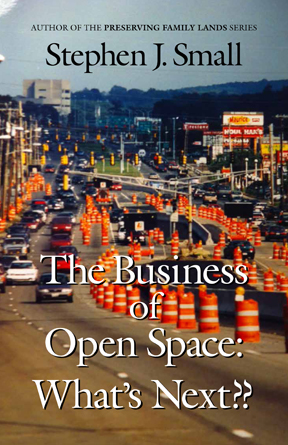Publications
Law Office of Stephen J. Small
The Business of Open Space: What's Next??
by Stephen J. Small, Esq. 8.29.13
“The business of open space has been fueled by philanthropy and government money. It is time to move beyond that,” says Stephen J. Small, in his new book, The Business of Open Space: What’s Next?? “Historically, land has been valued by how much development it could support,” Steve says. “We need to learn to value land in new and dynamic ways.”
In this exciting and challenging new book, Steve lays out an agenda to expand the business of saving open space. He advocates the creation of new marketplaces that set values on “environmental commodities,” reaching out to “non-traditional” landowners, such as corporations, educational institutions, and government agencies, creating new pools of money, and “leveraging acquisition dollars.”
Mr. Small also reminds readers that 2013 may be the last year landowners can take advantage of the enhanced conservation easement tax deduction, and provides tax calculations to illustrate the current rules.
To date, Mr. Small has been involved in the protection of more than 1.5 million acres of land across the United States. “Much land has been saved; much more remains to be protected,” he notes.
If you care about moving the “business” of open space forward over the next decade, you can’t just read this book – you need to read this book and then act on this important agenda.
Go to www.stevesmall.com for ordering details.
Enhanced Income Tax Deductions Extended Through 2011!!
by Stephen J. Small, Esq. 1.1.11
“Finally, after months of waiting, Congress extended the enhanced income tax deductions for conservation easement donations made through the end of 2011. The rules are the same rules that have been in effect for the past few years. That is, a landowner who donates a conservation easement before the end of this year can take the deduction for the donation up to 50% of adjusted gross income, with a 15-year carry forward of any unused amount. Many landowners who are actively in the farming, ranching, or forestry business can take the deduction up to 100% of adjusted gross income, with a 15-year carry forward. ”
These rules are all discussed in great detail in Preserving Family Lands: Book I.
It is possible that Congress will extend the incentives after 2011, and it is also possible Congress will make the incentives permanent. The Land Trust Alliance, at www.landtrustalliance.org, has led the fight for the incentives over the years and is now working hard to make the incentives permanent. But is also possible, of course, that the enhanced incentives will expire at the end of this year, in which case we will revert to the deduction rules that were in place under prior law. See Preserving Family Lands: Book I for a longer discussion of these rules.
As I have said to many landowners many times, if you want to be certain to take advantage of the enhanced incentives, you should plan to complete your donation this year, and you need to get started now!
Better Deductions for S Corporations That Donate Conservation Easements
by Stephen J. Small, Esq. 10.21.08
A minor provision included in the huge “bailout” bill that became law early this month could result in more important conservation easement donations this year and next year. Most landowners will not be impacted by this provision at all, but for S corporation landowners this is very good news.
BACKGROUND
The provision and the tax rules are technical but very important. Historically, the tax rule has been that when an S corporation made a charitable contribution, the contribution flowed through to the shareholders of the S corporation, but only to the extent they had “basis” in their S corporation stock. “Basis” is really a tax concept; often it means the same thing as “cost,” but sometimes “cost” and “basis” are different. Let’s take a simple example.
The New Conservation Tax Incentives
by Stephen J. Small, Esq. 10.14.08
On August 17, 2006, the President signed into law the Pension Protection Act of 2006. That law included the first major new income tax incentives for land conservation since 1980.
The new incentives applied to donations made before December 31, 2007. The new incentives expired at the end of the year last year. This past summer, Congress extended the incentives and they apply to donations made this year (2008) and next year (2009).
What follows is essentially the article I wrote last year on the incentives. It appears that the provisions of the original incentives will be extended in their entirety.
Forbes Article on New Incentives
by Stephen J. Small, Esq. 6.11.08
Land conservation charities had a banner year in 2007, as big landowners rushed to take advantage of a temporary expansion of the federal tax break for donating land development rights before it expired on Dec. 31, 2007.
But like other tax goodies originally handed out temporarily, the break for “conservation easements” is getting a second serving. As part of the new farm bill, Congress is extending the break through 2009, with an extra sweetener for farmers and ranchers thrown in.
Encouraging Landowners to Save the Places They Love
by Stephen J. Small, Esq. 10.17.07
The clock is ticking for landowners who want to take advantage of generous federal tax incentives encouraging conservation easement donations.
Last Call
by Stephen J. Small, Esq. 7.31.07
The new conservation tax incentives are huge. Individuals— and corporations—need to act immediately. It’s almost too late
